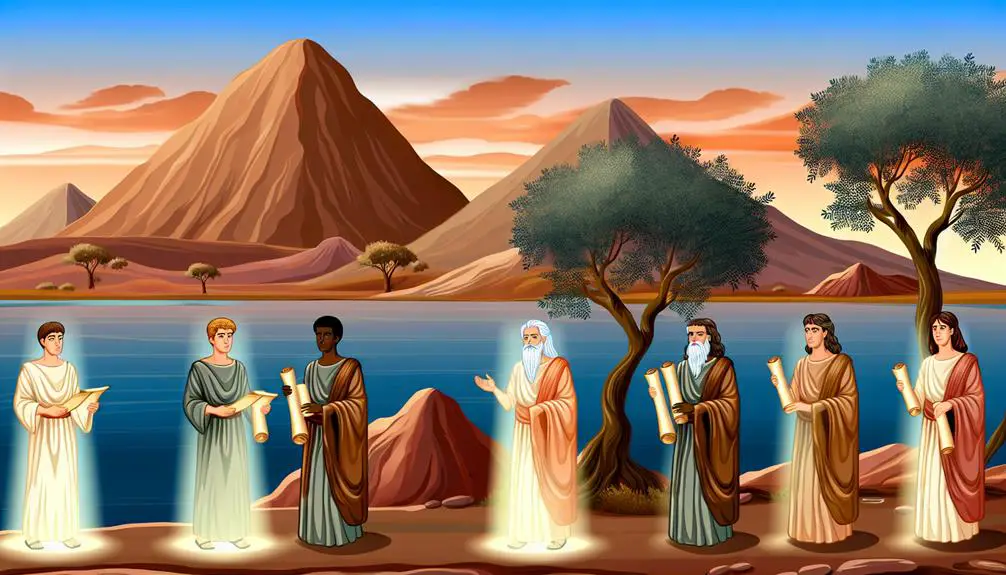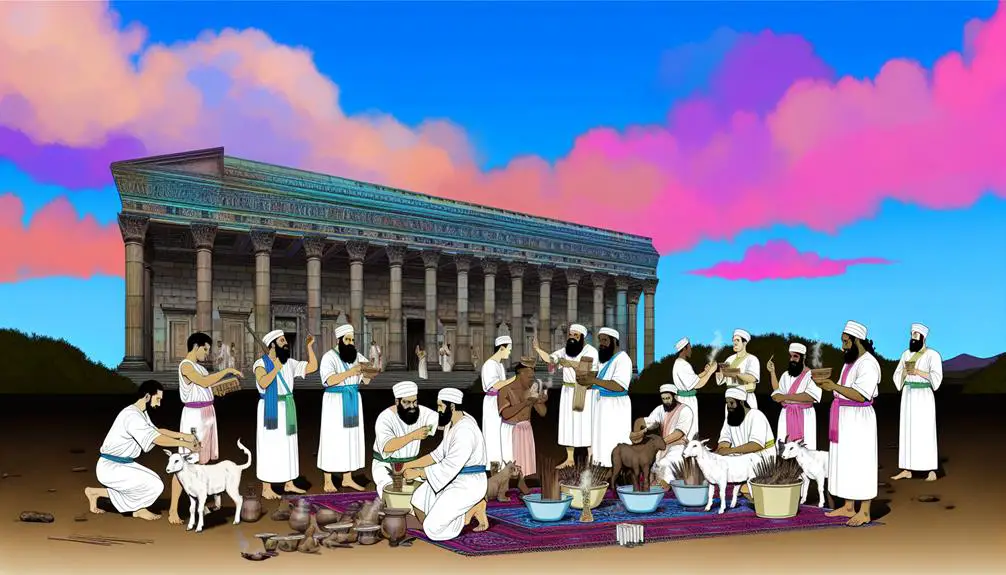Uncover how the Bible's diverse media forms, from scrolls to dreams, offer unique insights into divine communication and its impact on modern media.

Media in the Bible
Have you ever considered how the Bible itself challenges traditional notions of media? From stone tablets to scrolls, the Bible encapsulates a diverse range of media forms used to convey divine messages.
You'll find that prophets, parables, and even dreams served as unique channels of communication, each with its own purpose and audience. As you explore this topic further, ponder how these ancient methods of communication influence our understanding of spiritual messages today.
What might they reveal about the nature of divine interaction with humanity? This question opens a door to a deeper appreciation of biblical narratives and their relevance in contemporary discussions about media.
Key Takeaways
- Various media, including stone tablets, scrolls, and manuscripts, played essential roles in preserving and disseminating divine laws.
- Modern technology and digital adaptations have transformed how ancient biblical texts are engaged with and understood today.
- Symbols, signs, and parables in the Bible enrich the text with deep symbolic meanings and moral teachings.
- Oral traditions, prophets, and divine messengers have been pivotal in conveying God's instructions and maintaining communal bonds across generations.
Stone Tablets: God's Commands

In the context of divine communication, the stone tablets bearing God's commandments represent a foundational instance of media within biblical narratives, embodying both the permanence and sacredness attributed to divine laws. This form of media, unlike ephemeral spoken words, ensured that the divine commandments were preserved in a tangible form, accessible across generations. The choice of stone as a medium underscores a deliberate intent to convey the enduring nature of these laws, a stark contrast to the fleeting nature of oral traditions.
As you delve deeper into the implications of these stone tablets, it's crucial to recognize how modern technology and digital adaptations have transformed our understanding and engagement with these ancient texts. Today, digital platforms offer unprecedented access to biblical scriptures, allowing for interactive and immersive experiences that were unimaginable in the past. These digital adaptations, while vastly different in form from the stone tablets, share the same core objective: to preserve and disseminate divine commandments to a broad audience.
The evolution from stone tablets to digital texts exemplifies the dynamic interplay between divine communication and human technological advancement, highlighting how sacred texts adapt to remain relevant in an ever-changing technological landscape.
Scrolls and Manuscripts
You'll find that scrolls and manuscripts represent a significant evolution in the media used to record biblical texts.
Ancient writing materials and the preservation techniques employed to maintain these documents over millennia underscore the ingenuity and reverence of their creators.
This shift not only facilitated the spread of religious texts but also laid the groundwork for modern approaches to document preservation.
Ancient Writing Materials
Throughout history, scrolls and manuscripts have served as the primary mediums for recording and disseminating the sacred texts of the Bible. Central to this process was the art of papyrus production, a labor-intensive method that transformed the papyrus plant into a durable writing surface.
This ancient technology enabled the creation of scrolls that could withstand the rigors of time and use. Alongside, ink formulations were meticulously developed, combining soot or other pigments with binders to ensure that the sacred words inscribed upon these scrolls and manuscripts remained legible across centuries.
These materials weren't merely chosen for their availability but for their proven durability and resilience, qualities essential for preserving the divine messages they carried.
Preservation Techniques
Having explored the materials and methods used to create scrolls and manuscripts, let's now examine the sophisticated techniques employed to preserve these ancient texts for future generations. Preservation of these invaluable documents involves a multifaceted approach:
- Climate Control: Maintaining optimal humidity and temperature conditions to prevent deterioration.
- Digital Archiving: Utilizing technology to create high-resolution digital copies, ensuring accessibility while protecting the physical originals.
- Physical Handling Protocols: Implementing strict guidelines for handling to minimize physical wear and tear.
- Chemical Treatments: Applying non-invasive chemical treatments to strengthen the materials against decay.
These methods reflect a blend of historical reverence and modern innovation, safeguarding the legacy of biblical media against the ravages of time and environmental factors.
Prophets: The Divine Messengers

In the biblical narrative, prophets serve as the divine messengers, tasked with conveying God's instructions and warnings to humanity. Their roles encompass miracle validation, where supernatural occurrences affirm their divine appointment, and providing ethical guidance, steering communities towards moral rectitude. This dual function underscores the prophets' pivotal position in the spiritual and social fabric of biblical societies.
Prophet |
Miracle Example |
Ethical Guidance |
|---|---|---|
Moses |
Parting the Red Sea |
The Ten Commandments |
Elijah |
Fire from heaven |
Condemnation of Baal worship |
Isaiah |
Prophecy of Christ |
Call to social justice |
Analyzing this, one notes that miracles not only validate the prophets' authority but also cement their messages, making ethical guidance more impactful. Their life stories, filled with profound encounters and divine communications, offer rich insights into how divine will intersects with human history. Through their narratives, the Bible presents a complex interplay between divine intervention and human agency, illustrating how ethical living and spiritual devotion were communicated across generations. The prophets' legacy, thus, extends beyond their miraculous acts to their enduring call for righteousness, justice, and compassion in human relations.
Parables: Stories With Purpose
You'll find that parables serve a unique educational purpose in biblical texts, often conveying complex moral and spiritual lessons through simple, relatable stories.
Interpreting their symbolic meanings requires a nuanced understanding of the historical and cultural context in which they were told.
This approach not only enriches your comprehension of these narratives but also highlights their enduring relevance in contemporary discourse.
Parables' Educational Value
Parables, as employed in biblical texts, serve a profound educational purpose by encapsulating moral and spiritual lessons within engaging narratives. Through the lens of narrative pedagogy, these stories do more than entertain; they instruct and illuminate, offering moral illustration in a way that's accessible and resonant.
- Facilitate Deep Understanding: They simplify complex moral landscapes into relatable situations.
- Encourage Self-Reflection: Readers are prompted to consider their own actions and beliefs.
- Promote Memory Retention: Vivid narratives are more easily remembered than abstract principles.
- Foster Empathy: By putting oneself in the shoes of the characters, readers gain insights into others' experiences.
In this manner, parables act as a bridge, conveying profound truths through the simplicity and power of story.
Interpreting Symbolic Meanings
Delving deeper into the layers of parables reveals a rich tapestry of symbolic meanings, each designed to illuminate spiritual truths and ethical lessons.
Modern interpretations of these narratives often depend on understanding the cultural contexts in which they were originally told. You'll find that each parable's symbols and scenarios aren't arbitrary but deeply rooted in the everyday life and struggles of their initial audiences.
This historical and cultural sensitivity is crucial for unlocking the parables' full significance in today's world. By analyzing these stories within their original contexts, you can grasp the universal lessons they convey, transcending time and cultural boundaries.
This approach not only enriches your comprehension but also allows these ancient stories to resonate with contemporary relevance and wisdom.
Temple Worship and Rituals

In the context of biblical times, temple worship and rituals formed the cornerstone of spiritual and communal life for the Israelite people. These practices were rich and multifaceted, encompassing a wide range of activities that were both symbolic and literal in their significance.
Key components of temple worship and rituals included:
- Musical Instruments: Harps, lyres, and cymbals weren't just accompaniments but integral to worship, setting the tone for prayer and celebration.
- Sacrificial Offerings: Animals, grains, and incense were offered to God, symbolizing devotion, repentance, and the desire for purification.
- Priestly Duties: Priests played a crucial role, acting as intermediaries between God and the people, conducting sacrifices, and maintaining the sanctity of the temple.
- Festivals and Holy Days: These were times of communal gathering, remembrance, and joy, where the history and faith of the Israelite people were celebrated.
These elements combined to create a rich tapestry of worship that was both deeply personal and communal, reflecting the complex relationship between the Israelite people and their God.
Letters of the Apostles
Exploring the Letters of the Apostles offers insight into early Christian theology, practice, and community dynamics through the personal correspondence of key figures. These letters, embodying Apostolic authorship, serve as foundational texts for understanding the beliefs and organizational structure of the early Church. The epistolary functions extend beyond mere communication; they act as theological treatises, pastoral guidance, and communal binding tools.
You'll find that the Apostles utilized these letters to address specific issues within emerging Christian communities, often responding to questions or controversies that arose. This targeted approach allowed for the dissemination of doctrinal clarity and ethical instructions tailored to each community's needs. Through Apostolic authorship, these letters carry an authoritative weight, grounding Christian practice and belief in the teachings and experiences of those closest to Jesus.
Moreover, the epistolary format facilitated the spread of Christianity across geographical and cultural boundaries. The circulation of these letters among early Christian communities not only helped in maintaining doctrinal consistency but also in fostering a sense of unity and shared identity among disparate groups. In essence, the Letters of the Apostles are pivotal in tracing the evolution of early Christian thought and the consolidation of the Church.
Visions and Dreams

While the Letters of the Apostles offer a foundation in early Christian doctrine and community, visions and dreams in the Bible present a profound means by which divine guidance and revelation were conveyed to both leaders and laypersons. These instances of night visions and dream interpretation serve as crucial elements in understanding the multifaceted ways in which the divine communicates with humanity.
Here are four key aspects to consider:
- Historical Context: Biblical dreams often occurred at pivotal moments, offering guidance or foreshadowing significant events. Their interpretation required a deep understanding of both the divine will and the human condition.
- Symbolism: Dreams in the Bible are rich in symbolism, requiring discernment to unravel their meanings. This symbolism often transcended the literal to convey deeper spiritual truths.
- Divine Communication: Night visions and dreams were seen as direct lines of communication from the divine, a way for God to impart wisdom, warnings, and prophecies to individuals.
- Cultural Significance: The practice and importance of dream interpretation varied across different cultures within the Bible, reflecting a broader understanding of the divine across ancient societies.
These elements underscore the complexity and significance of visions and dreams as a form of media in biblical times, offering insight into divine-human interaction.
Oral Traditions and Teachings
Bridging the gap between generations, oral traditions and teachings served as the primary medium for conveying religious beliefs, moral values, and historical narratives within the ancient communities detailed in the Bible. This form of media wasn't merely about relaying information; it was deeply entwined with the social and spiritual fabric of these societies.
Tribal ceremonies, for instance, weren't just gatherings but pivotal events where oral traditions came to life, knitting the community closer through shared heritage and divine narratives.
You'll find that storytelling techniques weren't random or simplistic. They were crafted with care, often employing repetition, mnemonic devices, and vivid imagery to ensure retention and transmission of these tales across generations. These methods underscore an inherent understanding of the human psyche and memory, acknowledging the power of a well-told story to inspire, instruct, and unify.
Analyzing these oral traditions and teachings reveals a complex, richly layered method of communication that transcended mere words. It was about preserving identity, faith, and communal bonds. In this context, you can appreciate how these ancient practices laid the groundwork for modern religious and cultural narratives, highlighting the enduring power of the spoken word.
Symbols and Signs

Symbols and signs in the Bible function as powerful communicative tools, embedding deep spiritual truths and historical narratives within their forms. These elements offer a unique window into the theological and cultural underpinnings of biblical times, providing readers with insights into the complex interplay between the divine and the human, the natural and the supernatural.
Here are four key types of symbols and signs in the Bible:
- Animal Imagery: Often, animals aren't merely animals; they symbolize virtues, vices, or divine attributes. The lamb represents innocence and sacrifice, while the serpent often symbolizes temptation and evil.
- Celestial Bodies: Stars, the moon, and the sun are frequently employed to depict guidance, divine oversight, or the passage of time. They underscore the majesty of creation and the Creator's power.
- Numbers: Specific numbers carry deep symbolic meanings. For instance, the number seven signifies completeness or perfection, often associated with God's creation week.
- Colors: Colors aren't randomly chosen; they serve as visual shorthand. White often conveys purity, red can signify sacrifice or danger, and purple denotes royalty or authority.
These symbols and signs enrich the text, inviting readers to delve deeper into its layers of meaning.
Frequently Asked Questions
How Have Modern Interpretations and Depictions of Biblical Media Influenced Contemporary Religious Practices and Beliefs?
Modern interpretations, particularly through social media influence and cinematic adaptations, have significantly shaped your understanding and engagement with religious practices and beliefs. These mediums have democratized the interpretation process, allowing you to access diverse perspectives.
They've also modernized storytelling, making ancient narratives more relevant and engaging for you. This evolution has led to a more personalized and varied expression of faith, reflecting a broader spectrum of contemporary religious experiences.
In What Ways Have Non-Canonical Texts and Media Found Within or Related to the Bible Impacted Theological Discussions or Historical Understandings of Biblical Times?
You're diving into how non-canonical texts, like the Gnostic Gospels and the Apocrypha, have shaped theological debates and historical perceptions. These texts offer alternative narratives and insights, challenging traditional interpretations and enriching our understanding of biblical times.
Their influence isn't just academic; it's profoundly personal, pushing scholars and believers alike to rethink doctrines and historical contexts. Analyzing these works, you're uncovering layers of belief and history that were once obscured.
How Do Different Religious Denominations View the Authenticity and Significance of Digitally Preserved or Transmitted Biblical Media, Such as Online Scriptures or Sermons?
You're exploring how faith communities perceive digital versions of sacred texts and sermons. Digital platforms have revolutionized sermon accessibility, making spiritual guidance available anytime, anywhere.
However, views on their authenticity and significance vary widely among religious denominations. Some embrace these resources, seeing them as tools for spreading their faith, while others question the depth of engagement and understanding that digital formats can foster compared to traditional, physical mediums of scripture study and worship.
What Role Has the Media Within the Bible Played in Influencing Art, Literature, and Culture Outside of Strictly Religious Contexts?
You're standing at the crossroads of history where biblical narratives have sculpted our world.
The media within the Bible, like a cinematic Exodus or musical Psalms, has deeply influenced art, literature, and culture beyond church walls.
It's not just about faith; it's about the universal themes of human experience they convey.
This rich tapestry has inspired countless artworks, novels, and performances, proving its enduring impact on global cultural landscapes.
How Do Linguistics and the Translation of Biblical Media Affect the Interpretation and Understanding of Its Messages Across Different Languages and Cultures?
When you delve into how translations and linguistic nuances shape the understanding of texts, you're tackling a complex issue.
Translation technology and cultural adaptation play crucial roles here. They're not just about converting words; they're about conveying meanings, emotions, and cultural contexts across languages.
This process can significantly alter interpretations, revealing how deeply languages and cultures influence the reception and perception of messages, beyond mere literal translation.
Conclusion
In the tapestry of biblical communication, threads of divine dialogue weave through the warp and weft of human history. Stone tablets, scrolls, and parables aren't just ancient artifacts; they're the DNA of spiritual discourse, encoding God's messages within the fabric of society.
As you've seen, from temple rituals to apostolic letters, each medium served its purpose, mirroring the multifaceted nature of divine revelation. In essence, understanding these mediums is akin to decoding the syntax of the soul, offering a richer comprehension of faith's foundational texts.



Sign up